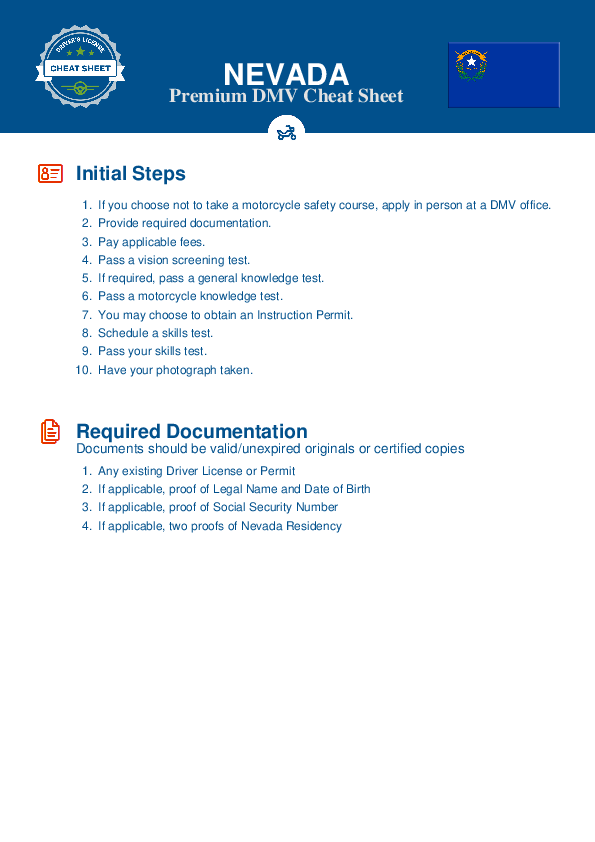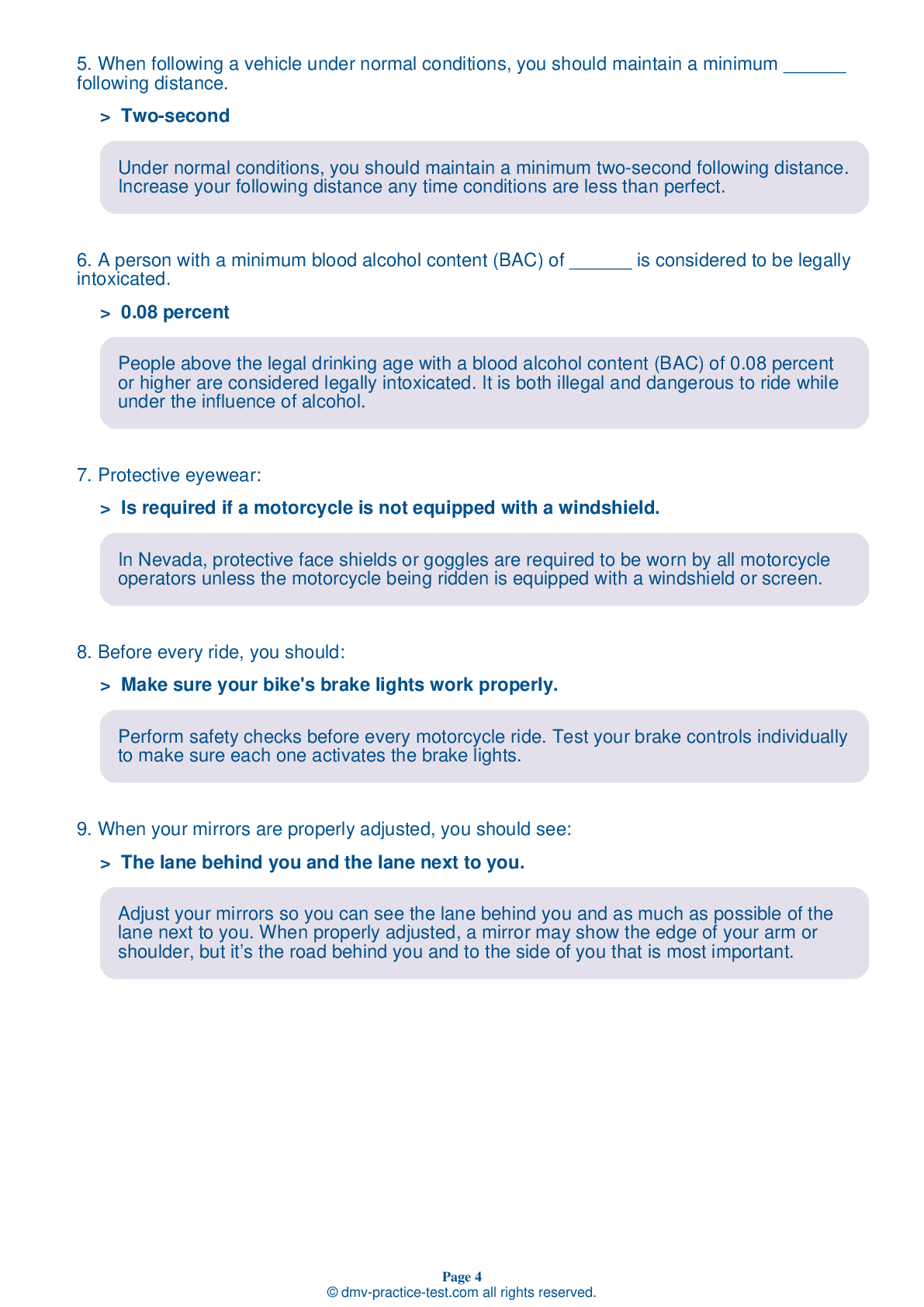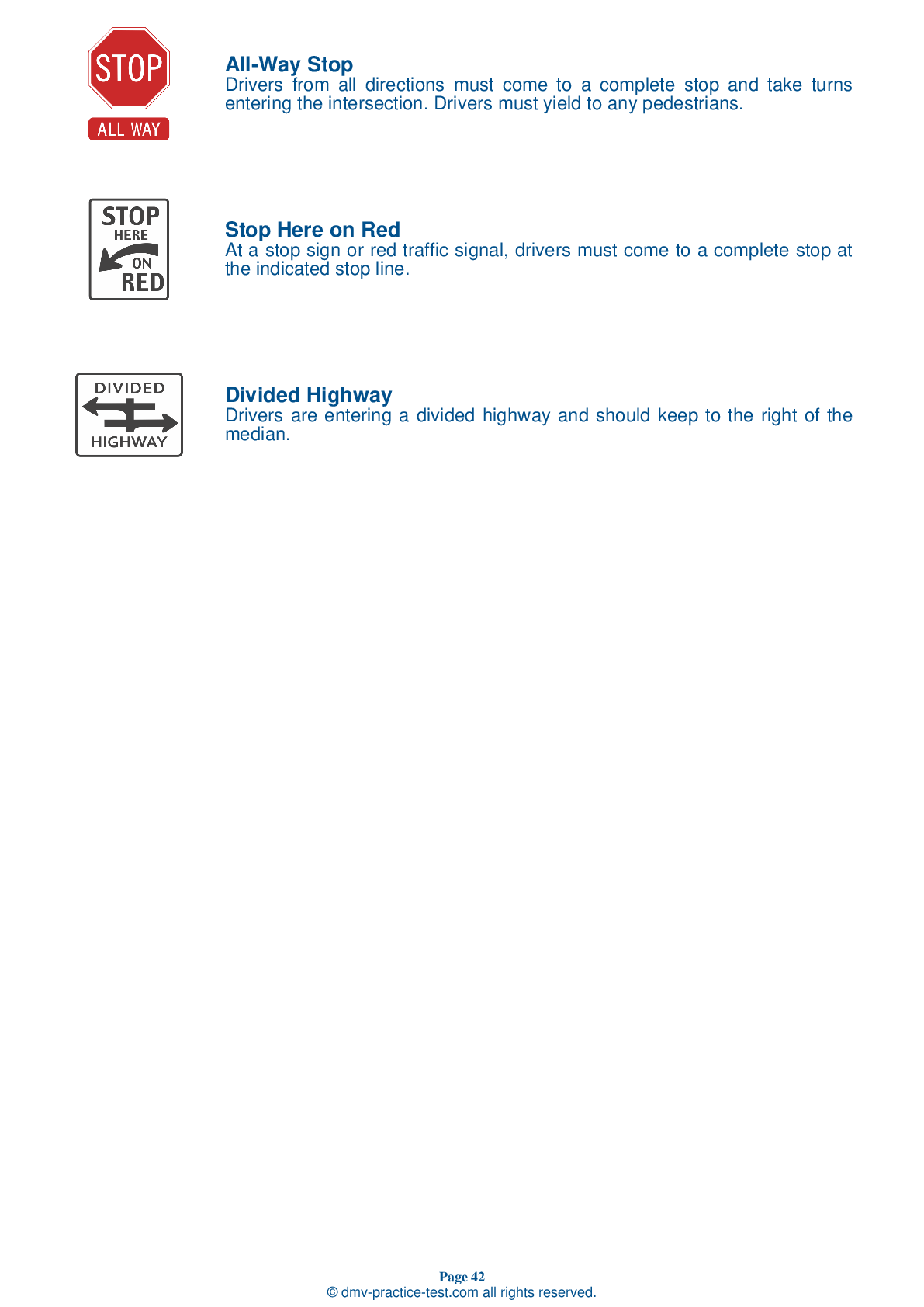DMV Permit Test #15
Motorcycle Test | License NV 2025 | FREE Online Practice! #15
Take this FREE motorcycle test (license in NV 2025) to check your knowledge of the road rules. To improve your results, download a motorcycle handbook online, study theory, and practice for free on our website. Still worried about how to get a motorcycle license in Nevada in 2025? Check our website for more sample tests, train as much as possible, and boost your grades!
25
20
16
1 . When upshifting, the first thing you should do is:
Roll off the throttle and release the clutch lever.
When upshifting, you should first roll off the throttle as you squeeze the clutch lever. Next, lift the shift lever firmly as far as it will go. Smoothly ease out the clutch and roll on the throttle as you complete the gear shift.
2 . When turning a three-wheeled motorcycle, you should:
Lean your body drastically away from the turn.
When entering a turn on a three-wheeled motorcycle, you should decrease your speed and slightly lean your upper body in the direction that you intend to turn. Steer your front wheel toward the turn and accelerate gradually as you exit the curve.
3 . If a motorcyclist stops at a red stop light but their motorcycle does not trigger the red light to change, the motorcyclist:
Should back up and re-approach the signal to try to trigger the change.
In Nevada, if a motorcyclist stops at a red stop light but their motorcycle does not trigger the red light to change, they may proceed straight or turn after two cycles of the traffic light have been completed. They may not turn if another device or sign prohibits the turn. The motorcyclist must yield to any other traffic or pedestrians.
4 . Motorcycles must be equipped with all of the following, except:
A seat for two people.
In Nevada, a motorcycle must be equipped with either one or two headlights; a red taillight; a stop light or brake light; at least one rear reflector; front and rear brakes; electric turn signals (if manufactured after 1973); a rearview mirror on each handlebar; fenders on both wheels; footrests; a horn; and a muffler.
5 . When braking, you should:
Only use the rear brake.
Use both brakes every time you slow or stop, regardless of the condition of the road.
6 . To cross tracks that run parallel to your lane, you should:
Wait for the tracks to end.
To safely cross trolley tracks, railroad tracks, ruts, or pavement seams running parallel to your lane, move to a lane position that will allow you to cross them at an angle of at least 45 degrees. Then, make a quick, sharp turn. If you try to edge across, the tracks or seam could catch your tires and throw you off balance.
2025 Nevada | Frequently Asked Questions
To acquire a motorcycle driver's license in Nevada, you must first obtain a motorcycle instruction permit by passing a written test. After that, you need to complete a DMV-approved motorcycle safety course. Once the course is completed, you can apply for a full license. If you're under 18, you'll need to hold the permit for six months before applying.
In Nevada, the minimum age to obtain a motorcycle driver's license is 16 years old. However, before you can get a full motorcycle license, you must first obtain a motorcycle instruction permit. To do this, you must be at least 15 and a half years old, pass a vision test and a written test.
Yes, in Nevada, you need a dedicated motorcycle license, known as a Class M license, to legally operate a motorcycle. This requires passing a written test and skills test. If you already have a regular driver's license (Class A, B, C), you can add a motorcycle endorsement to it by passing the necessary tests.
To apply for a motorcycle driver's license in Nevada, you'll need proof of your identity, such as a valid U.S. passport or birth certificate. You also need proof of your Social Security number, like a Social Security card or W-2 form. Additionally, two documents proving your Nevada residential address are required, such as utility bills or rental agreements. If applicable, bring your current driver's license too.
Yes, you will need to take a written exam to get a motorcycle license in Nevada. The exam tests your knowledge of motorcycle operation, traffic rules, and safety procedures. If you successfully complete an approved motorcycle safety course, the written test may be waived. However, all applicants must pass a skills test or present a skills test waiver to get their license.
The motorcycle written test in Nevada covers a variety of subjects related to safe and legal motorcycle operation. These include understanding traffic signs and signals, rules of the road, safe riding techniques, protective gear, effects of alcohol and drugs on riding, handling dangerous surfaces, carrying passengers and cargo, and dealing with mechanical problems.
Yes, it's possible in Nevada. If you successfully complete a Motorcycle Safety Foundation (MSF) course, you can bypass the written and skills tests at the DMV. The course provides a certificate of completion that you present at the DMV as proof of your training and understanding of motorcycle operation.
Enrolling in a motorcycle training course in Nevada involves finding a DMV-approved provider, signing up for a course that fits your level of experience, and paying any associated fees. The course typically includes both classroom instruction and hands-on training. After successful completion, you'll receive a certificate which you can present at the DMV when applying for your motorcycle license.
No, you do not have to own a motorcycle to take the license test in Nevada. You can use a borrowed motorcycle as long as it is registered, insured, and passes a basic safety inspection. However, you must be comfortable and familiar with the motorcycle you're using for the test.
Yes, you can use a friend's motorcycle for the license evaluation in Nevada, provided the motorcycle is legally registered, insured, and meets all safety requirements. It's important to ensure you are comfortable and familiar with the motorcycle before using it for the test.
Yes, Nevada's motorcycle driving exam tests specific handling skills. These include your ability to start and stop, turn and swerve, and negotiate intersections. You'll also be evaluated on quick stops, obstacle avoidance, and your overall control of the motorcycle. It's essential to demonstrate proficiency in these areas to pass the exam.
Yes, in Nevada, new motorcycle drivers are subject to certain restrictions. They must complete a DMV-approved motorcycle safety course before obtaining a full license. Additionally, riders under 18 must hold a motorcycle instruction permit for six months, maintain a clean driving record, and cannot carry passengers or ride between sunset and sunrise.
Yes, your Nevada driver's license with a Class M endorsement allows you to operate a motorcycle in other states. However, you must comply with the motorcycle laws and regulations of the state you're visiting. It's advisable to familiarize yourself with these rules before traveling.
Yes, in Nevada, it is mandatory for all motorcycle riders and passengers to wear a helmet that meets the standards set by the U.S. Department of Transportation. This law applies to mopeds as well. The helmet law is strictly enforced to ensure the safety of riders on Nevada's roads.
In Nevada, there isn't a variety of motorcycle licenses, but there is a Class M endorsement which can be added to any regular license. This endorsement allows the license holder to operate motorcycles. To obtain this, you must pass a knowledge test, an on-cycle skills test, and a vision test.
Yes, in Nevada, you can add endorsements to your motorcycle license. Endorsements allow you to operate additional types of vehicles. For instance, a Class M endorsement allows you to operate motorcycles. To add an endorsement, you'll typically need to pass a written test and a skills test related to the specific vehicle type.
Yes, in Nevada, the motorcycle license test is available in several languages other than English. These include Spanish, Filipino (Tagalog) and more. However, it's recommended to confirm the availability of your preferred language at your local DMV office. Remember, the test questions are based on the Nevada Motorcycle Operator Manual, regardless of the language.
An effective strategy to prepare for the Nevada motorcycle license test is to study the Nevada Motorcycle Operator Manual thoroughly. This manual covers all the information needed for the test. Additionally, taking online practice tests can help familiarize you with the format and types of questions you may encounter on the actual test.
Yes, in Nevada, the motorcycle written exam is offered in multiple languages besides English. These include Spanish, Filipino (Tagalog), and many others. You can request your preferred language when scheduling your test. However, it's advisable to confirm the availability of your preferred language at your local DMV office.
Yes, retaking is allowed in Nevada if you don't pass the motorcycle written test. However, you must wait for a day before retaking the test. If you fail three times, you'll need to start the application process over again. Always study the Nevada Motorcycle Operator Manual to increase your chances of passing.



